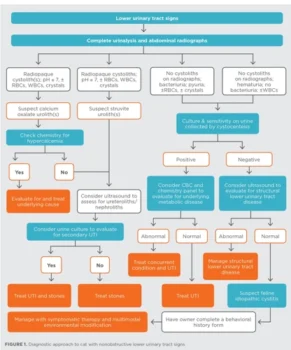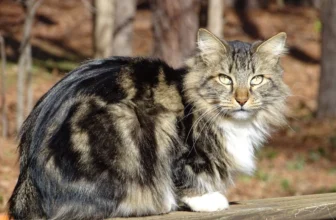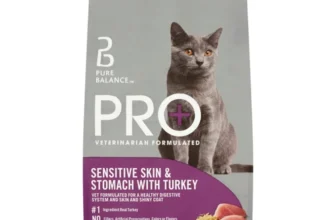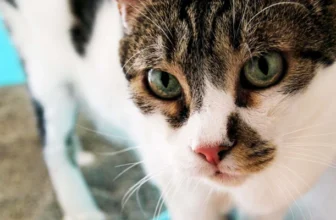As cat owners, it can be heartbreaking to watch our furry friends suffer from health issues. One common problem that American Bobtail cats may face is urinary tract infection. This condition can be painful and require prompt treatment. However, as with any health issue, prevention is always better than cure. In this article, we will discuss the causes, signs, and risk factors of urinary tract infection in American Bobtail cats, as well as the diagnosis and treatment methods available. We will also explore ways to prevent this condition from happening. So if you’re concerned about your cat’s urinary health, read on to learn more.
Overview of Urinary Tract Infection in American Bobtail Cats
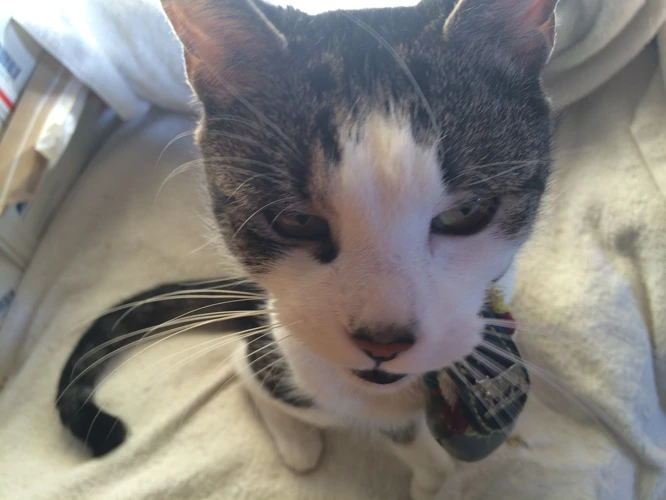
Urinary Tract Infection (UTI) is a commonly occurring ailment in American Bobtail Cats. A UTI is an infection in any part of the urinary system, including the bladder or kidneys. This condition can cause discomfort and pain for your feline friend, and if left untreated, it can even be fatal. As a responsible pet owner, it is essential to be aware of the causes, signs, and preventive measures for UTIs in American Bobtail Cats. In this article, we will dive into the specifics surrounding this condition and provide you with steps to help diagnose and treat UTIs in your beloved pet. Understanding UTIs in American Bobtail Cats is crucial for their health and well-being, and that’s why we’ve compiled information that will help you towards this aim. Let’s get started by learning more about the causes, signs, and risk factors of UTIs in American Bobtail Cats. For more information, visit Understanding UTI in American Bobtail Cats.
Causes of Urinary Tract Infection in American Bobtail Cats
Urinary tract infection (UTI) in American Bobtail cats can be caused by a variety of factors. Here are some of the most common causes of UTI in this breed:
- Bacteria: Bacterial infections are the most common cause of UTI in cats, including American Bobtail cats. The bacteria can enter the urinary tract through the urethra, bladder, or even the kidneys. Common bacteria that cause UTI in cats include Escherichia coli, Staphylococcus, and Proteus.
- Bladder stones: Sometimes, the formation of bladder stones, also known as uroliths, can lead to UTI in cats. These stones can cause irritation and damage to the lining of the bladder, making it easier for bacteria to infect the area.
- Diabetes: Cats with diabetes are more prone to UTI. High blood sugar levels can impair immune functions and affect the natural flora of the urinary tract, making it more susceptible to bacterial infections.
- Stress: Just like humans, cats can experience stress, and this can weaken their immune systems. Stress can also cause changes in the pH level of the urine, which can make the urinary tract more hospitable to bacteria.
- Anatomy: In rare cases, UTI in American Bobtail cats can be caused by abnormalities in the urinary tract structure, such as a narrow or obstructed urethra.
It’s important to note that UTI in cats can also be idiopathic, meaning that the cause is unknown. However, by understanding these common causes, you can take steps to prevent UTI in your American Bobtail cat. For more information on UTIs in Bobtail cats, you can visit our article on UTIs in Bobtail Cats. And, for tips on how to prevent UTI in your furry friend, head over to our article on Prevention of UTI in American Bobtail Cats.
Signs of Urinary Tract Infection in American Bobtail Cats
It is important for Bobtail cat owners to be aware of the signs that their feline friend may have a urinary tract infection (UTI). If left untreated, UTIs can lead to serious health complications.
Here are some common signs of UTI in American Bobtail Cats:
- Straining to urinate
- Frequent urination in small amounts
- Blood in urine
- Licking genital area excessively
- Loss of bladder control
- Crying or meowing during urination
- Urinating outside of the litter box
- Lethargy or decreased activity levels
- Loss of appetite
- Vomiting
If you notice any of these symptoms in your American Bobtail cat, it is important to seek veterinary care immediately. UTIs can be painful and cause discomfort for your pet, so it is crucial to have them treated as soon as possible.
Risk Factors for Urinary Tract Infection in American Bobtail Cats
Urinary tract infections (UTIs) in American Bobtail cats are caused by a variety of factors that can increase their susceptibility to the condition. Knowing the risk factors will help pet owners prevent and manage UTIs in their cats.
One of the main risk factors for UTIs in American Bobtail cats is gender. Female cats are more prone to UTIs compared to males because their urethra is shorter and located near the anus, making it easier for bacteria to travel up into the urinary tract.
Another significant risk factor for UTIs is age. As cats age, their immune systems become weaker, making them more vulnerable to infections. Common age-related illnesses such as diabetes and kidney disease can also increase the likelihood of developing a UTI.
Poor hygiene is also a risk factor for UTIs in American Bobtail cats. If their litter box is not kept clean, urine can accumulate bacteria that can transfer to their urinary tract. Additionally, cats that are not groomed regularly can carry bacteria and dirt, leading to an increased risk of infection.
Certain medications and medical conditions can also increase the risk of developing UTIs in American Bobtail cats. For example, if a cat is on long-term antibiotic treatment for another condition, it can disrupt their natural gut flora, leading to a greater chance of developing a UTI. Medical conditions such as bladder stones and tumors can obstruct the urinary tract, leading to bacterial growth and infection.
Lastly, stress can be a significant risk factor for UTIs in American Bobtail cats. Cats that have experienced a change in their environment or routine, such as moving to a new home or the introduction of a new pet, can be more prone to UTIs due to the impact on their immune system.
By being aware of the risk factors for UTIs in American Bobtail cats, pet owners can take preventative measures to reduce the chance of their cat developing an infection. Regular veterinary check-ups and exams can also help detect early signs of illness and allow for timely treatment.
| Risk Factors for UTIs in American Bobtail Cats |
|---|
| Gender (Female) |
| Age |
| Poor Hygiene |
| Medications and Medical Conditions |
| Stress |
If you want to learn more about UTIs in American Bobtail cats, check out our article on UTIs in Bobtail Cats.
Diagnosis of Urinary Tract Infection in American Bobtail Cats
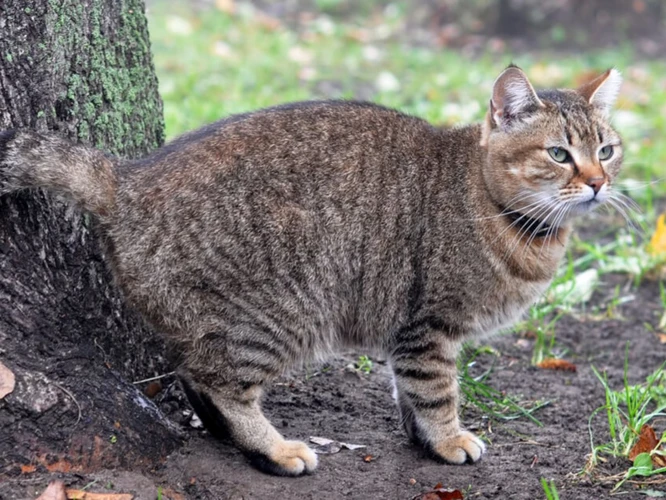
When it comes to diagnosing a urinary tract infection (UTI) in your American Bobtail cat, it’s important to consult with a veterinarian as soon as possible. UTIs can cause discomfort and even lead to serious health problems if left untreated. The process of diagnosing a UTI involves a series of steps, including a thorough physical exam, urinalysis, urine culture, imaging tests, and blood tests. Your vet will use these methods to determine the cause of your cat’s UTI and develop an effective treatment plan. Let’s take a closer look at the diagnostic process for UTIs in American Bobtail cats.
Veterinarian Exam and History Taking
When it comes to diagnosing urinary tract infection (UTI) in American Bobtail cats, a veterinarian exam and history taking is an essential first step. During the physical exam, the veterinarian will carefully palpate the cat’s lower abdomen to check for any signs of pain or discomfort. Additionally, they may perform a rectal exam to assess the size and texture of the prostate gland in male cats, as this gland can become inflamed during a UTI.
History taking involves gathering information about the cat’s symptoms and medical history from the owner. This can help establish the duration and severity of symptoms, as well as identify any underlying medical conditions or medications that could be contributing to the UTI.
To get an accurate understanding of the cat’s urinary health, the veterinarian may ask questions related to the frequency of urination, the appearance and odor of the urine, and any changes in litter box behavior. They may also inquire about the cat’s diet, as certain ingredients or formulations can increase the likelihood of UTIs.
A thorough veterinarian exam and history taking is an essential starting point for diagnosing UTIs in American Bobtail cats. By gathering as much information as possible about the cat’s urinary health and overall medical history, the veterinarian can make an informed decision about the most appropriate diagnostic tests and treatment options.
Urinalysis and Urine Culture
Urinalysis and urine culture are important diagnostic tools for detecting urinary tract infections (UTIs) in American Bobtail cats. A urinalysis involves testing a urine sample for the presence of bacteria, blood, and abnormal levels of substances such as protein and glucose. A urine culture involves growing bacteria from a urine sample on a culture plate to identify the specific type of bacteria causing the UTI.
Urinalysis
A urinalysis evaluates the physical, chemical, and microscopic properties of a urine sample. The physical properties examined include the color, clarity, and specific gravity of the urine. In cats with UTIs, the urine is often cloudy and has a strong, unpleasant odor. The chemical properties examined include the presence of protein, glucose, ketones, and bilirubin in the urine. Elevated levels of protein and glucose may be indicative of a UTI. The microscopic properties examined include the presence of red blood cells, white blood cells, and bacteria in the urine. Increased white blood cells and bacteria are a strong indication of a UTI.
Urine Culture
A urine culture involves collecting a sterile urine sample and growing bacteria from the sample on a culture plate. The bacterial growth on the plate is observed and identified under a microscope to determine the specific type of bacteria causing the UTI. The bacterial count can also be determined to guide antibiotic therapy. The sensitivity of the bacteria to different antibiotics can also be tested to determine which antibiotic would be most effective in treating the UTI.
| Diagnostic Tool | Method | Benefits |
|---|---|---|
| Urinalysis | Examines physical, chemical, and microscopic properties of urine | Can help identify the presence of a UTI |
| Urine Culture | Cultures bacteria from a urine sample and identifies the specific type of bacteria causing the UTI | Guides antibiotic therapy and determines antibiotic sensitivity |
It’s important to note that a negative result on a urine culture does not necessarily rule out a UTI, as some bacteria such as mycoplasma and ureaplasma may not grow on standard culture plates. In cases of persistent or recurrent UTIs, further testing may be necessary to identify these bacteria. Urinalysis and urine culture are important diagnostic tools in the detection and management of UTIs in American Bobtail cats.
Imaging Tests
Imaging tests are an important tool for diagnosing urinary tract infections (UTIs) in American Bobtail cats. The two primary types of imaging tests used in diagnosing UTIs are X-rays and ultrasounds.
X-Rays: X-rays can provide detailed images of the bladder and kidneys, allowing veterinarians to identify any abnormalities in these organs. They can also be used to rule out other conditions, such as bladder stones or tumors, which may present similar symptoms to UTIs. During an X-ray, the cat is positioned on a table and held still while the imaging is taken. In most cases, no sedation is required for an X-ray.
Ultrasounds: Ultrasounds are another commonly used imaging test for diagnosing UTIs in American Bobtail cats. They use sound waves to create images of the bladder and kidneys, giving veterinarians a detailed look at these organs. Ultrasounds can also be used to detect urinary tract obstructions or abnormalities in the urinary tract. During an ultrasound, the cat may require light sedation as they need to lay still for a longer period of time.
It is important to note that imaging tests are not always required in diagnosing UTIs in American Bobtail cats, but they can be particularly helpful in identifying underlying conditions that may be contributing to the infection. Your veterinarian will decide if imaging tests are necessary based on the results of the other diagnostic tests and the overall health of your cat.
| Imaging Test | Procedure | Sedation Required? |
|---|---|---|
| X-Ray | Provides detailed images of bladder and kidneys to identify abnormalities or rule out other conditions | No, in most cases |
| Ultrasound | Uses sound waves to create detailed images of bladder and kidneys, can detect urinary tract obstructions or abnormalities | May require light sedation |
If your American Bobtail cat is exhibiting symptoms of a UTI, it is important to contact your veterinarian right away. Your veterinarian will use a combination of diagnostic tests, including imaging tests, to identify the cause of the infection and develop a treatment plan that will help your cat feel better as quickly as possible.
Blood Tests
Blood tests are an important part of the diagnosis of urinary tract infection (UTI) in American Bobtail cats. These tests help to identify any underlying conditions that may be contributing to the UTI. Some of the common blood tests that a veterinarian may order include:
| Test | Description |
|---|---|
| Complete blood count (CBC) | A CBC measures the number of red and white blood cells in the bloodstream. Elevated levels of white blood cells can indicate the presence of an infection in the body. |
| Blood chemistry panel | This panel evaluates the levels of various chemicals in the bloodstream, including electrolytes, glucose, and liver and kidney function. Abnormalities in these levels may indicate an underlying condition, such as kidney disease. |
| Coagulation tests | These tests assess the cat’s blood clotting ability. UTIs can sometimes lead to the formation of kidney stones, which can cause blood in the urine and affect blood clotting. |
While blood tests are not always necessary to diagnose a UTI, they can be helpful in identifying any underlying conditions that may be contributing to the cat’s symptoms. By identifying and addressing these underlying issues, veterinarians can provide more effective treatment and help prevent future UTIs. If your American Bobtail cat is showing signs of a UTI, be sure to consult with your veterinarian as soon as possible to ensure prompt diagnosis and treatment.
Treatment of Urinary Tract Infection in American Bobtail Cats

When it comes to treating urinary tract infections (UTIs) in American Bobtail cats, early detection and intervention are crucial for a successful outcome. UTIs in cats can be painful and debilitating, and if left untreated, they can lead to serious complications. Fortunately, there are several treatment options available that can effectively manage UTIs in American Bobtail cats. Let’s explore the available treatment options, including antibiotics, pain management, fluid therapy, urinary acidifiers, and surgery.
Antibiotics
When it comes to treating Urinary Tract Infections (UTIs) in American Bobtail Cats, antibiotics are the most common method used by veterinarians. Antibiotics work by killing bacteria that are present in the urinary tract, which is causing the infection. This helps to alleviate the symptoms and cure the infection. However, it is important to note that antibiotics only work on bacterial infections and not on viral or fungal infections.
Some of the most common antibiotics that are used to treat UTIs in cats include Amoxicillin, Penicillin, Cephalexin, and Clavamox. The type of antibiotic and dosage prescribed will depend on the severity of the infection and the overall health of the cat.
It is crucial to follow the full course of antibiotics, even if your American Bobtail Cat starts feeling better after a few days. Stopping the medication early can cause the remaining bacteria to become resistant to the antibiotic. This can make further treatment more difficult and lengthy.
It is important to give antibiotics at regular, evenly spaced intervals throughout the day. Missing a dose or giving them intermittently can reduce the efficacy of the medication. It is also important to give the antibiotics on an empty stomach, as food can decrease their absorption.
While antibiotics are generally safe for most cats, there is always a risk of side effects. Some of the most common side effects of antibiotics include vomiting, diarrhea, and loss of appetite. If you notice any side effects, it is important to contact your veterinarian immediately.
While antibiotics are undoubtedly an important tool in treating UTIs, it is important to give them as prescribed, monitor your American Bobtail Cat for any side effects, and follow up with your veterinarian to ensure that the infection has been fully treated.
Pain Management
Pain management is an important aspect of treating urinary tract infection in American Bobtail cats. Urinary tract infections can cause discomfort and pain while urinating, which can make cats avoid the litter box and potentially worsen the infection.
There are several methods for pain management in cats with urinary tract infections. These include:
| Method of Pain Management | Description |
| Nonsteroidal anti-inflammatory drugs (NSAIDs) | These medications can reduce inflammation and pain in the urinary tract. However, NSAIDs should only be used under veterinarian supervision as they can have potential side effects. |
| Bladder protectants | Some bladder protectants, such as pentosan polysulfate sodium (PPS) and glucosamine, can help to soothe the bladder lining and reduce inflammation. |
| Alpha-2 agonists | These medications can help to reduce pain and discomfort related to urinary tract infection, but they should also only be used under veterinarian supervision. |
| Herbal supplements | Some herbs, such as cranberry and echinacea, may be helpful in reducing inflammation and supporting urinary tract health. However, it’s important to discuss the use of herbal supplements with a veterinarian before giving them to your cat. |
It’s important to note that pain management should always be done under the guidance of a veterinarian. Some over-the-counter pain medications that are safe for humans can be toxic to cats, so it’s important to never give your cat medication without consulting with a vet.
In addition to medication, providing a calm and stress-free environment can also help to reduce pain and discomfort for cats with urinary tract infections. This can include providing a quiet space for your cat to rest and ensuring that the litter box is easily accessible and clean.
Pain management is an important part of treating urinary tract infection in American Bobtail cats. By working with a veterinarian and providing a caring environment for your cat, you can help to reduce discomfort and promote healing.
Fluid Therapy
Proper hydration is essential for the treatment of urinary tract infections (UTIs) in American Bobtail cats. The veterinarian may recommend fluid therapy as part of the treatment plan. This involves administering fluids to the cat either subcutaneously or intravenously to help regulate the balance of fluids and electrolytes in their body.
Here are some key things to know about fluid therapy for treating UTIs in American Bobtail cats:
- Fluid therapy helps flush out the bacteria causing the UTI and also helps to prevent dehydration, which can make UTI symptoms worse.
- Cats with more severe UTIs may require hospitalization for fluid therapy, while others may be able to receive fluids as outpatients.
- The type of fluid and amount administered will depend on the cat’s individual needs and the severity of their infection.
- If the cat is unable to drink water or is experiencing vomiting or diarrhea, fluid therapy can be especially important to help prevent dehydration while they recover from their UTI.
- Fluid therapy may also help alleviate some of the discomfort or pain caused by the UTI, as it can help to flush out irritants and toxins from the urinary tract.
It is important to follow the veterinarian’s instructions carefully when administering fluid therapy to your American Bobtail cat. If your cat is receiving subcutaneous fluids at home, the veterinarian may provide instructions on how to safely administer them. Be sure to monitor your cat’s urine output, as well as their overall behavior and appetite, and report any concerning changes to the veterinarian. By working with your veterinarian and following their recommended treatment plan, you can help your American Bobtail cat recover from their urinary tract infection and get back to their playful, healthy self.
Urinary Acidifiers
Urinary acidifiers are a type of medication that can be prescribed by a veterinarian for the treatment of urinary tract infections (UTIs) in American Bobtail cats. These medications work by acidifying the cat’s urine, which can help to dissolve any crystals that may be present in the urinary tract.
Types of Urinary Acidifiers: There are different types of urinary acidifiers including potassium citrate, DL-methionine, and ammonium chloride.
How They Work: Urinary acidifiers work to lower the pH level of a cat’s urine. By doing so, they can help to dissolve any crystals that may be present in the urinary tract. These medications can also help to prevent the formation of new crystals.
Side Effects: While urinary acidifiers are generally safe, they can cause side effects in some cats. These may include vomiting, diarrhea, and loss of appetite. It is important to monitor your cat closely while they are taking urinary acidifiers and to report any changes in behavior or appetite to your veterinarian.
Usage: The correct dosage of urinary acidifiers will depend on your cat’s specific condition and the type of medication prescribed. It is important to follow your veterinarian’s instructions carefully and to give the medication exactly as directed.
To ensure the safety and effectiveness of urinary acidifiers, it is important to only give them to your American Bobtail cat under the guidance of a veterinarian. Your vet will be able to provide specific dosages, options, and monitor your cat for any potential side effects. Along with a solid treatment plan, you can help your cat on the road to recovery from a urinary tract infection by providing them the necessary resources and medical care needed.
Surgery
In severe cases of urinary tract infection in American Bobtail cats, surgery may be required to remove blockages or address underlying issues. Surgery is typically reserved as a last resort option when other treatments have failed or the infection has become life-threatening.
Types of Surgery:
- Cystotomy: This surgical procedure involves making an incision in the bladder to remove stones, growths, and other obstructions that may be causing the urinary tract infection. After the procedure, the cat may need a urinary catheter to help them urinate properly.
- Urinary Tract Reconstruction: This is a complex surgery that is performed when the urinary tract is severely damaged or not functioning properly. During this surgery, the veterinarian will reroute the urinary tract to correct the problem.
- Amputation: In rare cases, cats may experience recurring urinary tract infections that cannot be treated with antibiotics or other methods. In such cases, amputation of the affected organ may be necessary to prevent further infections.
Care After Surgery:
After surgery, it is important to provide your American Bobtail cat with proper post-operative care to ensure a speedy recovery. This may include antibiotics, pain management, and regular check-ups with the veterinarian.
It is also important to monitor your cat’s behavior and health closely after surgery. If you notice any signs of infection or complications, such as fever, loss of appetite, or difficulty urinating, you should contact your veterinarian immediately.
Surgery is a serious intervention that should only be considered when other treatments have failed or in life-threatening situations. If you suspect that your American Bobtail cat may have a urinary tract infection, it is important to seek veterinary care promptly to prevent the infection from progressing and potentially requiring surgery.
Prevention of Urinary Tract Infection in American Bobtail Cats
Taking steps to prevent urinary tract infection in American Bobtail cats can help ensure their long-term health and well-being. To avoid the discomfort and potential complications that may arise from this common condition, it is important to make certain changes and provide specific support for your feline friend. By implementing a few simple practices, such as managing the litter box and offering clean water, you can help reduce the risk of urinary tract infection and promote a healthy urinary system for your cat. In this section, we will discuss some effective prevention strategies that you can use to maintain optimal urinary function in your American Bobtail cat.
Dietary Changes
When it comes to preventing urinary tract infection (UTI) in American Bobtail cats, dietary changes play a crucial role. A well-balanced diet can prevent the recurrence of UTIs while ensuring good overall health for your cat. Here are some dietary changes you can make for your feline friend:
- Increase Water Intake: Dehydration can lead to concentrated urine, which can increase the risk of UTIs in cats. It’s essential to make sure your cat stays hydrated. One way to do that is by placing multiple bowls of water around the house in accessible locations. Additionally, you can add water fountains or wet food to your cat’s diet to encourage them to drink more water.
- Provide High-Quality Protein: American Bobtail cats require a protein-rich diet to maintain their muscle mass and overall health. However, not all proteins are created equal. It’s essential to choose high-quality protein sources such as chicken, turkey, and fish, as they are easier to digest and provide the necessary amino acids for your cat’s diet.
- Reduce Carbohydrate Intake: A diet that’s high in carbohydrates can lead to inflammation and an increased risk of UTIs in cats. It’s crucial to reduce the amount of carbohydrates in your cat’s diet. Try to choose cat food that’s low in grains and fillers such as soy or wheat.
- Incorporate Probiotics: Probiotics are beneficial bacteria that can help maintain a healthy gut environment. Adding probiotic supplements to your cat’s diet can strengthen their immune system and reduce the risk of developing UTIs by promoting good gut bacteria.
- Vitamin Supplementation: Vitamins such as C and E can help prevent inflammation and promote good urinary tract health. Be sure to choose cat food that’s rich in these vitamins, or supplement your cat’s diet with vitamins as recommended by your vet.
By incorporating these dietary changes, you can help prevent UTIs in your American Bobtail cat and ensure that they live a happy and healthy life.
Providing Clean and Accessible Water
Clean and accessible water is essential for preventing urinary tract infections in American Bobtail cats. The lack of water intake often leads to dehydration, which results in concentrated urine that contains a higher amount of bacteria, causing infections. To ensure your cat is drinking enough water, here are some tips:
| Tip | Explanation |
|---|---|
| Provide Fresh Water | Make sure to change water bowls frequently to maintain freshness, and ensure there are no contaminants or particles in the water. |
| Offer Multiple Water Sources | Having a water bowl in different areas of the house makes it easier for your cat to access water, particularly if they are not comfortable traveling long distances to get to a single source. |
| Invest in a Cat Water Fountain | Cat water fountains are particularly useful since they circulate water, making it more appealing and refreshing for your cat. Fountains often encourage cats to drink more water, promoting hydration. |
| Familiarize Them with Water | Some cats don’t recognize water as a source of hydration, particularly if they have only been provided with dry food. Gradually introducing wet food, adding water to their dry food, and offering tuna juice or chicken broth can help increase their water intake and promote hydration. |
Providing your American Bobtail cat with an accessible and clean water source is a crucial step in preventing urinary tract infections. It is essential to make sure your cat is drinking enough water to maintain hydration, encourage urination, and promote healthy bladder function. By following these tips, you can ensure your cat has a consistent and adequate water source and a lower risk of developing urinary tract infections.
Litter Box Management
Proper litter box management is crucial for preventing urinary tract infection in American Bobtail cats. Here are some tips to keep in mind:
- Clean the litter box regularly: A dirty litter box can attract germs and bacteria that can cause urinary tract infections. Clean the litter box at least once a day, and replace the litter entirely once a week.
- Provide enough litter boxes: Provide one litter box per cat, plus one extra. This will ensure that your cats don’t have to fight over litter boxes, and helps prevent any territorial issues.
- Use the right type of litter: Not all litters are created equal. Some litters have strong scents or harsh chemicals that can cause irritation or discomfort to your cat’s sensitive urinary tract. Choose a natural, unscented litter that your cat is comfortable with.
- Keep the litter box in a quiet, private area: Cats like privacy when using the litter box. Make sure the box is in a quiet, easily accessible area where your cat won’t be disturbed.
- Monitor your cat’s litter box habits: Keep an eye on your cat’s litter box habits. If your cat suddenly starts urinating outside the litter box or shows signs of discomfort when using the box, it could be a sign of a urinary tract infection.
By following these litter box management tips, you can decrease the risk of your American Bobtail cat developing a urinary tract infection.
Conclusion
In conclusion, it is crucial for American Bobtail cat owners to understand the causes, signs, and risk factors associated with urinary tract infections. If left undiagnosed and untreated, it can lead to serious complications such as kidney damage and even death. Therefore, prompt diagnosis and treatment is vital.
Proper diagnosis includes a thorough physical examination, urinalysis, imaging tests, and blood tests. Treatment typically involves antibiotics, pain management, fluid therapy, urinary acidifiers, and in severe cases, surgery.
Prevention is also an important aspect of managing urinary tract infections in American Bobtail cats. This includes making dietary changes, providing clean and accessible water, and managing litter boxes properly.
As responsible pet owners, it is our duty to ensure our furry friends are healthy and happy. By understanding and taking necessary steps to prevent and treat urinary tract infections in American Bobtail cats, we can ensure our cats live a long and healthy life. Remember to consult with a veterinarian at the first signs of any potential health concerns to ensure proper diagnosis and treatment.
Frequently Asked Questions
Can urinary tract infections be fatal for American Bobtail Cats?
If left untreated, urinary tract infections in American Bobtail Cats can lead to serious complications such as kidney damage, bladder rupture, and even death.
Are American Bobtail Cats more prone to urinary tract infections than other cat breeds?
There is no evidence to suggest that American Bobtail Cats are more prone to urinary tract infections than other cat breeds. Any cat can develop a UTI regardless of their breed.
Can I use over-the-counter medication to treat my American Bobtail Cat’s UTI?
No, you should never give your cat any medication without first consulting with your veterinarian. Over-the-counter medication can be toxic to cats and can even make their condition worse.
How long does it take for antibiotics to work on an American Bobtail Cat’s UTI?
The duration of treatment for a UTI in American Bobtail Cats can vary depending on the severity of the infection. In general, antibiotics are prescribed for at least 7-14 days and it can take up to 5 days for improvement to be seen.
What can I do to help prevent my American Bobtail Cat from getting a UTI?
You can help prevent your American Bobtail Cat from getting a UTI by providing them with clean and accessible water, providing litter boxes in multiple locations, and promoting exercise and play to encourage urination.
Can stress cause a UTI in my American Bobtail Cat?
Yes, stress can be a contributing factor in the development of UTIs in American Bobtail Cats. Stress can weaken their immune system and make them more susceptible to infections.
Can feeding my American Bobtail Cat a specific type of food help prevent UTIs?
Feeding your American Bobtail Cat a diet that is high in moisture and protein can help prevent UTIs by reducing the chance of the formation of crystals in the urine.
Can male American Bobtail Cats get UTIs?
Yes, male American Bobtail Cats can develop UTIs, although it is more common in females due to the fact that their urethra is shorter and wider.
What are the signs of a UTI in American Bobtail Cats?
The signs of a UTI in American Bobtail Cats include frequent urination, painful urination, blood in the urine, and urinating outside of the litter box.
When should I take my American Bobtail Cat to the veterinarian if I suspect they have a UTI?
You should take your American Bobtail Cat to the veterinarian as soon as possible if you suspect they have a UTI, as early treatment can prevent the infection from becoming more serious.

